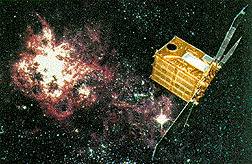Ginga
| Ginga (ASTRO-C) | |
|---|---|

|
|
| Type: | X-ray satellite |
| Country: |
|
| COSPAR-ID : | 1987-012A |
| Mission dates | |
| Dimensions: | 420 kg |
| Size: | 1000 × 1000 × 1550 mm |
| Begin: | February 5, 1987, 06:28 UTC |
| Starting place: | Kagoshima |
| Launcher: | M-3S2 |
| Status: | burned up on November 1, 1991 |
| Orbit data | |
| Rotation time : | 97 min |
| Orbit inclination : | 31 ° |
| Apogee height : | 510 km |
| Perigee height : | 670 km |
Ginga (Japanese for galaxy ) was a Japanese satellite for X-ray astronomy . Before it was renamed Ginga, the project was known as ASTRO-C .
history
Ginga was developed as the third Japanese X-ray satellite by the Institute of Space and Astronautical Science and was placed in low earth orbit (510 × 670 km, inclination 31 °) on February 5, 1987 with an M-3S2 rocket from the Kagoshima Space Center . On November 1, 1991, the mission ended with the re-entry into the earth's atmosphere. Ginga observed about 350 different X-ray sources in the sky during his lifetime.
Technical specifications
Ginga had a size of about 1000 × 1000 × 1550 mm and a takeoff mass of 420 kg. It was three-axis stabilized, which was done by a spin wheel , four gyro ( inertial reference systems ) and two star sensors as well as coils for alignment by the earth's magnetic field.
The payload consisted of three instruments that covered the energy range from 1 to 500 keV . The most important instrument ( large area proportional counter , LAC) was a large-scale, existing of eight individual sensors and collimators -provided steel proportional counter for the energy range from 1.5 to 37 keV, with an effective detector area of 4000 cm 2 and a field of view of 0, 8 ° x 1.7 °. Furthermore, a detector was bursts ( gamma-ray burst detector , GBD) installed with an effective collection area of 60 cm 2 , a time resolution of 31.3 ms and a field of view over the whole sky. It consisted of a proportional counter ( proportional counter , PC) and a Szintillationspektrometer ( scintillation detector , SC). The third instrument was an X-ray monitor for the entire sky ( all-sky monitor , ASM) for the energy range from 1 to 20 keV and an effective receiving area of 70 cm 2 and a field of view of 1 ° × 180 °. This consisted of two identical gas proportional meters, each with three detection areas of 1 ° × 45 °. <
Individual evidence
- ↑ https://imagine.gsfc.nasa.gov/features/satellites/archive/showcase_ginga.html
- ↑ LEDAS: Ginga Description ( Memento of the original from March 25, 2009 in the Internet Archive ) Info: The archive link was inserted automatically and has not yet been checked. Please check the original and archive link according to the instructions and then remove this notice.